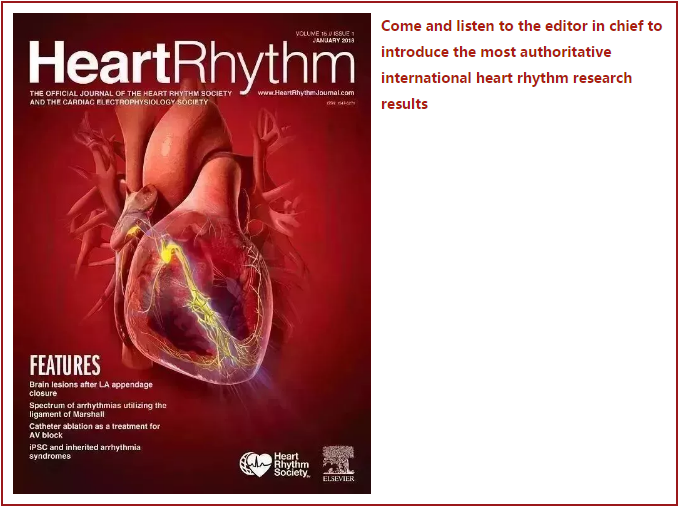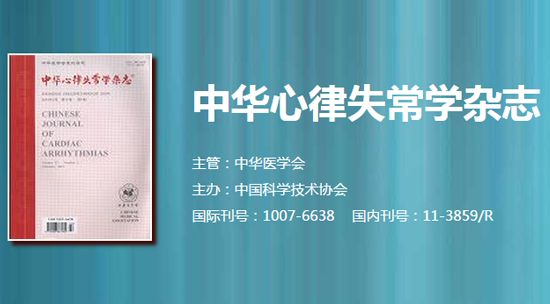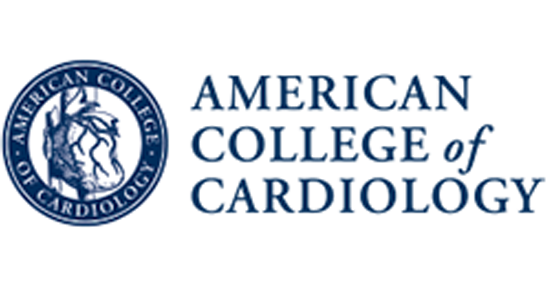HeartRhythm主编—陈鹏生教授语音速递(二月刊 英文版)


1
The featured article this month is “An Association between Right Ventricular Dysfunction and Sudden Cardiac Death”by Pandat et al. A comprehensive interview with the senior author, conducted by our online editor, Dr. Daniel Morin, can be found at the www.heartrhythmjournal.com website. The data came from a prospective ongoing community-based study of sudden cardiac death in the Portland, Oregon metro area. The authors found that RV dysfunction was associated with a significantly increased risk of sudden cardiac death independent of LVEF, and when combined with LVEF, had additive effects on sudden cardiac death risk. These findings have potential implications for sudden cardiac death risk stratification and warrant further prospective evaluation in larger populations.
2
The next article is titled “Risk of thromboembolic events after percutaneous left atrial appendage ligation in patients with atrial fibrillation” written by Mohanty et al. The authors studied consecutive patients undergoing LAA ligation with the Lariat device at multiple centers, with at least 1-year follow-up. They found that complete occlusion of the LAA with the Lariat device was associated with a low rate of thromboembolic events at long-term follow up. However, residual leaks were common after Lariat closure and the stroke rate was significantly higher in patients with incomplete occlusion, even with very small leaks. Therefore, it is important to identify the patients with leaks to prevent thromboembolism.
3
Next up is an article titled“Long-term Outcomes After Low Power, Slower Movement versus High Power, Faster Movement Irrigated-Tip Catheter Ablation for Atrial Fibrillation” by Bunch et al. The authors found that long-term freedom from AF rates were not significantly different between the two approaches. A high-power, short-duration ablation strategy compared to a low-power, long-duration approach was associated with an increased risk of atrial flutter and need for repeat ablation, but lowered procedure times. These findings suggest that more research needs to be done to improve the high-power, short-duration approach to ablation.
4
Janus et al wrote the following article, titled“High Sensitivity Troponin and the Risk of Atrial Fibrillation in Chronic Kidney Disease.” The authors studied about 4000 patients in a prospective cohort of chronic kidney disease patients. They discovered that high sensitivity troponin levels are associated with increased risk of atrial fibrillation in patients with mild to moderate chronic kidney disease. Previous studies showed that that high sensitivity troponin levels also are associated with other cardiovascular events, such as heart failure, stroke, peripheral artery disease, etc. However, the mechanism of this association remains unclear.
5
The next article is titled “Incidence of sleep apnea and association with atrial fibrillation in an unselected pacemaker population” by Marti-Almor et al. Sleep apnea monitoring is a pacemaker feature that measures the “respiratory disturbance index,” which is the sum of abnormal respiratory events divided by sleep duration. This investigation shows that sleep apnea screening over 12 months identified severe sleep apnea in almost one-third of unselected pacemaker patients. Severe sleep apnea was associated with a higher incidence of significant AF. These findings indicate that pacemakers equipped with sleep apnea monitoring algorithms may help identify patients with sleep apnea, which can then lead to appropriate therapy.
6
Next up is a paper by Canpolat et al, titled “Association of fragmented QRS with left atrial scarring in patients with persistent atrial fibrillation undergoing radiofrequency catheter ablation”. Fragmented QRS on the 12-lead ECG is a noninvasive marker of intra-myocardial conduction delay, often due to ventricular scarring, which has not been studied in AF before. The authors found that LA scarring was higher in patients with a fragmented QRS than those without. This simple, available, and noninvasive marker may be helpful in predicting the presence and severity of left atrial scarring prior to ablation procedures.
7
Strisciuglio et al wrote the next article titled “A Prospective Evaluation of Entrainment Mapping as an Adjunct to New Generations High-Density Activation Mapping Systems of Left Atrial Tachycardias”. The authors sought to investigate the added value of entrainment maneuvers when using new high-density activation mapping technologies for the identification of complex left atrial tachycardias. The results show that entrainment maneuvers remain useful during mapping of complex left atrial tachycardia, mostly to differentiate active from passive macro-reentrant loops and to demonstrate micro-reentry circuits.
8
Next up is a paper titled “Renal denervation as adjunctive therapy to cardiac sympathetic denervation for ablation refractory ventricular tachycardia,” written by Bradfield et al. This study included ten patients who underwent renal denervation after cardiac sympathetic denervation procedures, with median follow-up of 23 months. The results show that renal denervation has potential benefit when VT recurs after radiofrequency ablation and cardiac sympathetic denervation. However, the need for acute renal denervation after cardiac sympathetic denervation is associated with a poor prognosis. The potential benefit of renal denervation as a rescue procedure will need to be determined by larger studies.
9
The next article is “The role of extensive diagnostic work-up in young athletes and non-athletes with complex ventricular arrhythmias,” written by Narducci et al. The authors used various imaging and monitoring techniques to study young athletes and non-athletes with ventricular arrhythmias. They found myocarditis, ARVC, and/or focal fibrosis in over 20% of athletes. These data showed the need for an extensive diagnostic work-up in apparently healthy young patients with complex ventricular arrhythmias in order to characterize concealed cardiomyopathies.
10
Next up is an article by Sakamoto et al, titled “Surgical Procedure for Targeting Arrhythmogenic Substrates in the Treatment of Ventricular Tachycardia Associated with Cardiac Tumors.” The authors evaluated the surgical procedures and late outcomes of the treatment of VT associated with cardiac tumors in 6 patients. The 4 tumors were cryoablated or partially resected. There was no recurrence of clinical VT after a mean follow-up time of 90 months. These findings show that surgical treatment of VT associated with cardiac tumors is very effective. For those with non-resectable cardiac tumors, mapping-guided surgery was beneficial in eliminating VT.
11
The next article is “Right free wall accessory pathway with branched atrial insertions,” by Li et al. An average of three separate atrial insertions were documented among these 10 cases studied. All insertions were away from the tricuspid annulus by about 1-3 centimeters. These pathways need careful mapping and stepwise ablation. Single focal ablation is not likely to be successful in treating such pathways.
12
Nakamura et al wrote the next article titled “Impact of the type of electroanatomic mapping system on the incidence of cerebral embolism after radiofrequency catheter ablation of left atrial tachycardias”. The authors prospectively enrolled 59 patients who underwent a left AT ablation and brain MRI after the procedure. Either Rhythmia or CARTO was used. The results show that Rhythmia group exhibited a higher incidence of post-ablation cerebral embolism than the CARTO group. The authors conclude that the use of a mini-basket catheter to guide RF ablation of left atrial macroreentrant tachycardias may markedly increase the risk of silent cerebral embolism. The chief weakness of the study is that the mapping system used was not randomly assigned. A randomized trial will be needed to substantiate these observations.
13
The next article is titled“Chronic venous obstruction during cardiac device revision” by Morani et al. Out of 227 patients studied, 61, or 27%, showed a venous stenosis greater than 75%. Chronic venous obstruction is a relatively frequent finding after CIED implantation. The number of implanted leads seems to be an independent predictor of venous obstruction. In cases of stenosis, the pre-procedural angiographyguided structured approach allowed preservation of both contralateral access and functioning leads.
14
Jiang et al wrote the next article, titled “S wave in ECG lead V6 predicts poor response to cardiac resynchronization therapy and long-term outcome”. There were 54 patients with complete LBBB without an S wave in lead V5 or V6 , 32 with S in V5 and 26 with an S in both V5 and V6. CRT response rate was 85%, 66% and 39% respectively. These data indicate that an S wave in lead V6 can predict low response to CRT and poor long-term outcome. The mechanisms that underlie these observations remain unknown.
15
The next article is titled “The Many Faces of Early Repolarization Syndrome” by Voskoboinik et al. The authors studied 10 patients with early repolarization syndrome. The authors found that early repolarization syndrome is a heterogeneous condition and may be associated with both atrial and ventricular arrhythmias, AV block, dynamic electrocardiographic changes, and variable triggers. In addition to targeting PVC triggers, mapping and ablation of abnormal epicardial electrograms may be a potential treatment strategy.
16
Next up is an article titled “Difficulties with Invasive Risk Stratification Performed Under Anesthesia in Pediatric Wolff-Parkinson-White Syndrome,” by Shwayder et al. The gold standard for risk stratification in this population is the shortest pre-excited RR interval during atrial fibrillation, or “SPERRI.” The authors found that EP lab measurements of pathway characteristics made under general anesthesia do not correlate well with clinically-observed SPERRI. In addition, this study questions the predictive ability of invasive risk stratification under general anesthesia, given that 24% of patients with a high risk clinical-SPERRI (that is, ≤250ms) had a SPERRI at EP study that may be considered low risk (>250ms). A possible mechanism is the altered autonomic tone during general anesthesia.
17
The next article is “Wearable Cardioverter Defibrillators in Pediatric Cardiomyopathy: A Cost-Utility Analysis,” written by Evers et al. The authors evaluated the Wearable Cardioverter Defibrillator, abbreviated as WCD, using a social willingness-to-pay threshold of $50,000 per quality-adjusted life year. The authors found that based on existing literature regarding rates of sudden cardiac arrest in pediatric patients with dilated cardiomyopathy undergoing medical optimization prior to ICD implantation, sending a patient home with a WCD may be a cost-effective strategy. Conversely, keeping a patient in the hospital for that 3-month period for the purpose of continuous telemetry was not cost-effective.
18
Rossi et al contributed the following article, titled “A novel homozygous mutation in the TRDN gene causes a severe form of pediatric malignant ventricular arrhythmia.” Triadin is a protein expressed in cardiac and skeletal muscle, with an essential role in the structure and functional regulation of calcium release units and excitation-contraction coupling. Mutations in the triadin gene (TRDN) have been described in various forms of human arrhythmia syndromes. The authors identified a novel missense variant (p.L56P) in the TRDN gene in the homozygous proband, with one copy inherited from each of the heterozygous unaffected parents. In vitro analyses showed that the mutant protein can trigger arrhythmias by altering calcium homeostasis. These findings advance the understanding of arrhythmogenic potential of calcium handling proteins.
19
Up next is “Genetic Arrhythmias Complicating Patients with Dilated Cardiomyopathy” by Li et al. The authors performed a study into the genetic causes of arrhythmias in dilated cardiomyopathy patients. They found some arrhythmias in DCM patients are caused by arrhythmia-related pathogenic variants. For DCM patients with explicit arrhythmias, arrhythmia-causative genetic screening may help to explain the etiology of the cardiac arrhythmias.
20
Ackerman et al wrote the following article, titled “Utilization of the Genome Aggregation Database, In Silico Tools, and Heterologous Expression Patch Clamp Studies to Identify and Demote Previously Published Type 2 Long QT Syndrome-Causative Variants from Pathogenic to Likely Benign”. They studied 337 LQT2-associated missense variants. The authors offer compelling evidence for the 6 demotion of 22 out of 337(6.5%) KCNH2 variants previously described in the literature. The authors suggested that meticulous studies must be conducted for not only putatively pathogenic LQTS missense variants, but for the entire field of genetic heart disease to determine whether a variant is pathogenic or benign.
21
The next article is “Comparative spatial resolution of 12-lead electrocardiography and an automated algorithm.” The spatial resolution of pace-mapping using 12-lead ECG alone, versus quantitative morphology matching software, is unknown. The authors found that both quantitative morphology matching software coefficients and traditional pace-mapping showed a significant inverse linear correlation with distance from the origin. However, the resolution of the software is better than traditional pace mapping. These new methods may be helpful in determining the origin of tachycardias.
22
Yin et al wrote the following paper, titled “Effects of ondansetron on apaminsensitive small conductance calcium-activated potassium currents in pacinginduced failing rabbit hearts.” The authors performed optical mapping in rabbit hearts with pacing-induced heart failure, and also in normal hearts, both before and after ondansetron infusion. The results show that ondansetron at therapeutic concentrations is a specific blocker of the small conductance calcium activated potassium current, or SK current. The SK current is abundantly expressed in the atria. It is also expressed in the ventricles in patients with heart failure. By blocking this potassium current, ondansetron could be either antiarrhythmic or proarrhythmic, depending on the clinical condition.
23
The next article is a review by Roston et al on“Caring for the Pregnant Woman with an Inherited Arrhythmia Syndrome.” To achieve optimal outcomes, early involvement of an expert pregnancy heart team, comprising obstetrics, genetics, cardiology, and anesthesiology, and a shared decision-making approach to inherited arrhythmia syndrome in pregnancy, are needed.
I hope you enjoyed this podcast. For Heart Rhythm, I’m Editor-In-Chief, Dr. Peng-Sheng Chen.











